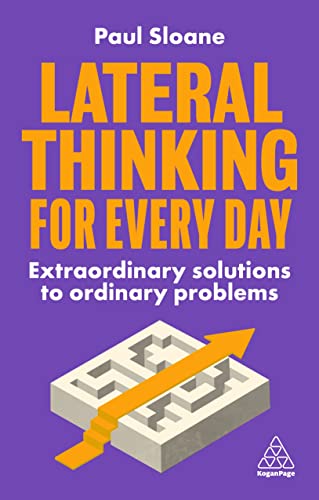Lateral thinking is a valuable skill that can help individuals solve problems and approach challenges in new ways. Whether you’re looking to improve your creativity, problem-solving abilities, or critical thinking skills, books on lateral thinking can be an excellent resource.
In this article, we’ve spent considerable time researching and testing various books on lateral thinking to identify the best ones available. We understand that choosing the right book can be challenging, which is why we’ve also included critical factors you should consider before making a purchase.
When selecting a book on lateral thinking, it’s essential to consider the author’s expertise, the book’s structure and format, and the specific techniques and exercises included in the book. By choosing a high-quality book that aligns with your learning style and goals, you can improve your lateral thinking skills and enhance your problem-solving abilities.
After thorough research and testing, we’ve identified the top books on lateral thinking that offer valuable insights and practical exercises to help you develop your lateral thinking skills.
Best Books on Lateral Thinking
We have compiled a list of the best books on lateral thinking to help you develop your creative problem-solving skills. Lateral thinking is an essential skill in today’s fast-paced world, and these books will teach you how to approach problems from a new perspective. Whether you’re a student, a professional, or simply looking to improve your problem-solving skills, these books are a must-read. So, without further ado, here are our top picks for the best books on lateral thinking.
Lateral Thinking Puzzlers

If you’re looking for a fun and challenging book on lateral thinking, Lateral Thinking Puzzlers is a great option.
Pros
- The book features 93 puzzles, ranging from easy to fiendish.
- The puzzles are divided into five chapters, making it easy to find puzzles of a particular difficulty level.
- The book is great for group activities or solo problem-solving.
Cons
- Some of the puzzles have answers that feel a bit arbitrary, making them frustrating to solve.
- A few of the puzzles are well-known classics, which may be disappointing for those looking for new challenges.
- The book is quite slim, with only 96 pages of puzzles.
We had a blast working through the puzzles in Lateral Thinking Puzzlers. The puzzles are well-designed and varied, with a good mix of riddles, logic puzzles, and other types of brain teasers. The book is great for group activities, as the puzzles can be solved collaboratively or competitively.
One thing we appreciated about the book is that the puzzles are organized by difficulty level, making it easy to find puzzles that are appropriate for your skill level. We also liked that the book includes a mix of classic puzzles and new challenges, so there’s something for everyone.
That said, there were a few puzzles that left us scratching our heads. Some of the answers felt arbitrary or overly convoluted, making them frustrating to solve. Additionally, a handful of the puzzles are well-known classics, which may be disappointing for those looking for entirely new challenges.
Overall, we’d definitely recommend Lateral Thinking Puzzlers to anyone looking for a fun and challenging book of lateral thinking puzzles. It’s a great way to exercise your brain and have some fun at the same time.
67 Lateral Thinking Puzzles

We highly recommend purchasing 67 Lateral Thinking Puzzles if you’re looking for a fun and challenging way to improve your lateral thinking skills.
Pros
- The puzzles are engaging and thought-provoking.
- The book is compact and easy to carry around.
- It’s a great way to pass the time and exercise your brain.
Cons
- The book is relatively short with only 61 pages.
- Some of the puzzles may be too easy for experienced lateral thinkers.
- The book is not suitable for children under 12 years old.
We found the puzzles in 67 Lateral Thinking Puzzles to be both entertaining and challenging. The puzzles are well-crafted and require a combination of creativity and logic to solve. We also appreciated the compact size of the book, making it easy to bring with us on trips or during commutes.
However, the book is relatively short with only 61 pages, which may be a disappointment for some readers. Additionally, some of the puzzles may be too easy for experienced lateral thinkers, although we still found them enjoyable. Lastly, we wouldn’t recommend this book for children under 12 years old, as some of the puzzles may be too difficult for them.
Overall, if you’re looking for a fun and engaging way to improve your lateral thinking skills, 67 Lateral Thinking Puzzles is definitely worth checking out.
Thanks for the Feedback… I Think? (BEST ME I Can Be!)

We highly recommend purchasing Thanks for the Feedback… I Think? (BEST ME I Can Be!) because it is an excellent book for children to learn about feedback and how to handle it.
Pros
- The book is engaging and easy to understand for children.
- The story is relatable and teaches valuable lessons about feedback.
- The book is short and can be easily read in one sitting.
Cons
- The book is only 32 pages long and may not provide enough depth for some readers.
- Some readers may find the nicknames of the characters unnecessary.
- The book is geared towards a younger audience and may not be as useful for older children.
Thanks for the Feedback… I Think? (BEST ME I Can Be!) is a great book for teaching children about feedback. The story follows a young boy named RJ who struggles with receiving feedback. He learns valuable lessons about handling feedback from his teacher and classmates. The book is engaging and easy to understand for children, and the story is relatable and teaches valuable lessons about feedback. The book is short and can be easily read in one sitting, making it a great addition to any child’s bookshelf.
In conclusion, if you are looking for a book to teach your child about feedback, we highly recommend Thanks for the Feedback… I Think? (BEST ME I Can Be!).
The Leader’s Guide to Lateral Thinking Skills: Unlock the Creativity and Innovation in You and Your Team

If you’re looking to unlock your creativity and innovation, this book is a must-read guide and toolkit for understanding innovation through lateral thinking.
Pros
- The book is accessible and actionable with tools and techniques that can be applied in real-world scenarios.
- The author provides relatable examples and case studies to support the concepts presented.
- The book is well-structured and easy to follow, making it an enjoyable read.
Cons
- Some readers may find the book to be too simplistic and lacking in depth.
- The puzzles and exercises provided may not be challenging enough for some readers.
- The book focuses more on the theory of lateral thinking rather than practical application.
We found The Leader’s Guide to Lateral Thinking Skills to be an excellent resource for anyone looking to enhance their creativity and innovation skills. The author provides a clear and concise explanation of lateral thinking and offers practical tools and techniques that can be applied in any situation. The book is well-structured and easy to follow, with relatable examples and case studies that support the concepts presented.
One of the standout features of this book is the puzzles and exercises provided. While some readers may find them too simplistic, we found them to be an excellent way to practice and apply the concepts presented in the book. The puzzles and exercises are designed to challenge your thinking and encourage you to approach problems from different angles.
Overall, The Leader’s Guide to Lateral Thinking Skills is a valuable resource for anyone looking to enhance their creativity and innovation skills. While the book focuses more on the theory of lateral thinking than practical application, the tools and techniques presented are actionable and can be applied in real-world scenarios. If you’re looking to unlock your creativity and innovation, we highly recommend this book.
The Science of Lateral Thinking

If you’re looking for a concise guide to lateral thinking, The Science of Lateral Thinking is a great option.
Pros
- Teaches the concept and types of lateral thinking in a concise manner
- Provides activities to practice what was taught
- Historical examples of innovative individuals using these techniques
Cons
- Only 53 pages long
- No X-Ray feature available
- Some of the activities may be too easy for those with prior experience in lateral thinking
We found The Science of Lateral Thinking to be a great introduction to lateral thinking. The book is concise and to the point, making it easy to understand the concept and types of lateral thinking. The activities at the end of the book were engaging and required implementing what was taught. We had a great time solving them, although some of the harder ones were a bit difficult.
The historical examples of innovative individuals using these techniques were interesting and helped to reinforce the importance of lateral thinking. However, at only 53 pages long, we felt that the book could have gone into more depth on the subject.
While the book has enhanced typesetting and is supported by screen readers, the X-Ray feature is not available. Additionally, some of the activities may be too easy for those with prior experience in lateral thinking.
Overall, if you’re looking for a quick and easy introduction to lateral thinking, The Science of Lateral Thinking is a great option.
Lateral Thinking Lessons and Puzzles

We highly recommend Lateral Thinking Lessons and Puzzles to anyone seeking to boost their creativity and leadership skills.
Pros
- The book offers simple and easy methods to unlock creativity and leadership ability.
- The puzzles are intriguing and challenging, making the book entertaining and fun to read.
- The book helps you to think outside the box and stimulates your thinking.
Cons
- The book is relatively short, with only 109 pages.
- The enhanced typesetting and word wise features are not enabled.
- The sticky notes feature is not enabled.
Lateral Thinking Lessons and Puzzles is a clever book that presents an entertaining way to build your lateral thinking skills. The book offers simple and easy methods to unlock creativity and leadership ability, making it a great resource for anyone looking to improve their problem-solving skills. The puzzles are intriguing and challenging, which makes the book entertaining and fun to read. Additionally, the book helps you to think outside the box and stimulates your thinking.
One of the cons of the book is that it is relatively short, with only 109 pages. This means that the book may not be as comprehensive as other books on lateral thinking. Additionally, the enhanced typesetting and word wise features are not enabled, which may be a drawback for some readers. Finally, the sticky notes feature is not enabled, which may be a downside for readers who like to take notes while reading.
In conclusion, Lateral Thinking Lessons and Puzzles is an excellent book for anyone looking to boost their creativity and leadership skills. While it may not be as comprehensive as other books on lateral thinking, the book offers simple and easy methods to unlock creativity and leadership ability, making it a great resource for anyone looking to improve their problem-solving skills.
Lateral Thinking for Every Day

If you’re looking for a book that can help you think outside the box, Lateral Thinking for Every Day is a great option.
Pros
- Enhanced typesetting, Word Wise, and Page Flip features make reading easier and more enjoyable.
- Sticky notes on Kindle Scribe allow you to jot down ideas and thoughts while reading.
- Offers practical advice and exercises to help you develop your lateral thinking skills.
Cons
- Some of the examples and exercises may seem a bit simplistic.
- The book is relatively short, so it may not cover all aspects of lateral thinking in depth.
- The Kindle version may not be ideal for those who prefer physical books.
We found Lateral Thinking for Every Day to be a useful and engaging read. The book is well-written and provides a good introduction to lateral thinking, with plenty of examples and exercises to help you develop your skills. The Enhanced typesetting, Word Wise, and Page Flip features make reading easier and more enjoyable, while the Sticky notes on Kindle Scribe allow you to jot down ideas and thoughts while reading.
One of the highlights of the book is its practical advice. The author provides a number of tips and tricks for developing your lateral thinking skills, such as using analogies, changing your perspective, and breaking down problems into smaller parts. These techniques are easy to understand and apply, making them useful for anyone looking to improve their problem-solving abilities.
However, some of the examples and exercises in the book may seem a bit simplistic to those who are already familiar with lateral thinking. Additionally, the book is relatively short, so it may not cover all aspects of lateral thinking in depth. Finally, while the Kindle version is convenient, some readers may prefer a physical book.
Overall, we would recommend Lateral Thinking for Every Day to anyone looking to improve their problem-solving skills and think more creatively. It’s an accessible and engaging read that provides practical advice and exercises for developing your lateral thinking abilities.
Buying Guide
When it comes to selecting the best book on lateral thinking, there are a few things to keep in mind. Here are some factors that we recommend considering:
Content
The first thing to look for is the content of the book. Look for books that offer in-depth explanations of lateral thinking concepts and techniques. Check to see if the book includes practical exercises and real-world examples to help you apply the concepts to your own life and work.
Author
Consider the author’s credentials and experience. Look for authors who have a background in psychology, creativity, or innovation. You may also want to look for authors who have experience in your field or industry.
Format
Consider the format of the book. Do you prefer a traditional text-only book, or do you prefer a book that includes illustrations, diagrams, or other visual aids? Do you prefer a book that is more interactive, with exercises and activities?
Reviews
Check out reviews of the book before making a purchase. Look for reviews from people who have similar interests or needs to your own. Consider both positive and negative reviews to get a well-rounded understanding of the book.
Price
Finally, consider the price of the book. While it’s important to invest in your education and personal development, you don’t want to overspend. Look for books that offer a good value for their price.
We hope that these factors help you choose the best book on lateral thinking for your needs.
Frequently Asked Questions
What are some recommended books for improving lateral thinking skills?
There are many great books that can help improve your lateral thinking abilities. Some of our top recommendations include “Lateral Thinking” by Edward De Bono, “Thinkertoys” by Michael Michalko, and “The Art of Possibility” by Rosamund Stone Zander and Benjamin Zander.
What are some of the best lateral thinking exercises to try?
There are many different exercises you can try to improve your lateral thinking skills. Some popular examples include the “Nine Dots” puzzle, the “Alternative Uses” exercise, and the “Random Word” technique. These exercises can help you break out of your usual patterns of thinking and come up with creative solutions to problems.
How can I develop my lateral thinking abilities?
There are many ways to develop your lateral thinking abilities, including reading books on the subject, practicing lateral thinking exercises, and exposing yourself to new and diverse experiences. It’s also important to challenge your assumptions and question your own thought processes.
What are some examples of lateral thinking puzzles?
Lateral thinking puzzles are designed to challenge your usual ways of thinking and encourage you to come up with creative solutions. Some examples include the “Man in the Elevator” puzzle, the “Two Doors” puzzle, and the “Matchstick” puzzle.
What are the key principles of lateral thinking?
The key principles of lateral thinking include breaking out of established patterns of thinking, challenging assumptions, and looking for alternative solutions. It’s also important to be open to new ideas and perspectives, and to approach problems with a sense of curiosity and playfulness.
Can lateral thinking be improved through audiobooks?
Yes, audiobooks can be a great way to improve your lateral thinking skills. Listening to books on the subject can help you gain new insights and perspectives, and can also provide you with practical exercises and techniques to try. However, it’s important to also practice these techniques in real-life situations to truly develop your lateral thinking abilities.





